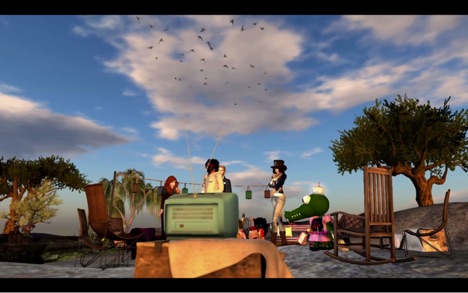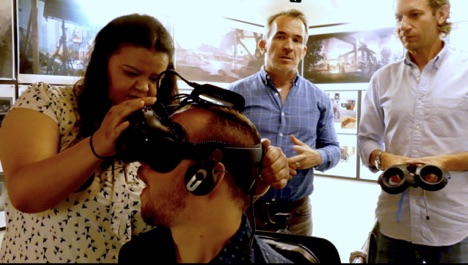Editor’s Note: This post was written by Donna Davis, PhD – University of Oregon and is the sixth post in the series on Disabling Technologies

Ethnographia, screenshot from the film, Our Digital Selves
Imagine sitting on the beach on a beautiful day. The sun is rising and the birds singing. Wisps of clouds gently float by as the surf rhythmically rolls in and out at your feet and the children frolic in the sand. You can almost feel the heat of the sun, only you can’t — because you’re sitting in a virtual world. Such is the experience of the childless agoraphobe who may never see the ocean again. Virtual worlds have always been places of both escape and entertainment. For people with disabilities, this notion of escape comes with far greater opportunity but also risk. The risk is that this escape is tied to a simplistic understanding of both virtual reality and disability – especially where people who have never experienced either assume an individual with disabilities may want to abandon their physical experience for the comfort of a virtual one.
This concern was made even more clear to me while attending a Disability Studies meeting at my university when one of the leaders who was clearly irritated turned to me and said, “oh you’re one of those people who thinks the virtual world is a place for all of us disabled people to go live happy lives.” Her frustration possibly came from a place of longstanding lack of understanding or respect from able-bodied people for the capabilities of people with disabilities (PWD). Or it could be interpreted as showing her willingness to explore creative alternatives to accessibility to experiences in the physical world.
Historically, computer-based immersive environments have been used in gaming cultures where people compete for reward and recognition through gaming skills, but programs such as the Sims, Minecraft and Second Life (SL) have also provided vibrant social spaces. These platforms have enormous user bases with more than 200 million Sims games installed (Sims VIP, 2016), 55 million players on Minecraft (Statistica, 2017) and more than 600,000 are still actively engaged in Second Life (Lee, 2017). As is the case in the game space, these worlds have also long been the source of fodder for popular press who consistently represent them as utopian environments that foster or facilitate dystopian outcomes such as escapism, deceit and addiction.
Our Digital Selves – the project
To better understand the promise and peril of social virtual worlds as experienced by PWD, in 2015 Tom Boellstorff at UC Irvine and I began working on a National Science Foundation grant, building on several years of work with a community of people with Parkinson’s disease. Our field site is Ethnographia, a virtual “island” in Second Life subdivided into parcels of land that our community could use to build whatever they choose. Although it began as a vast and barren swath of land, it quickly became a collection of homes, creative displays and immersive experiences that lead people on a journey of life experienced through the lens of both ability and disability. For example, one of our community members recreated a giant picnic table with a little girl sitting beneath it with a pile of books. Animated chat bubbles filled with gibberish float in and out above the adults sitting at the table, representing her experience as a deaf child at the family picnic. Another participant created a swamp, complete with the sounds of frogs and crickets, where she logs in and sits her gator avatar down to allow her mind to clear as she writes science fiction stories that she later publishes in the physical world. Approximately 35 people have either built homes, experiences, galleries or symbolic displays of what ability and disability mean to them, and/or they have regularly attended informal discussions guided by topics of their choosing in Ethnographia. Many of these stories will be told in Our Digital Selves, a documentary currently under development.
What we continue to learn from this community is that the affordances of virtual worlds, create opportunities to experience relationships, community, creativity, work and play in ways that uniquely suit the circumstances of their disability. When virtual worlds are no longer about escapism, the significance for many of these people becomes clearer. As one of the participants at a community event described, this virtual world provided her access to social connections as a person who was homebound. Another attendee responded with a quick, “homebound? What about room bound”. To which another responded, “room bound? what about bed bound?” For these individuals, their disabilities do not provide regular access to the physical world beyond the walls of their homes.

A representation of the experience of being deaf as created by one community member in Ethnographia.
While this is not the case for all of the people in our community, others have lost employment (or never had access to employment) as a result of their disability and discrimination in its many forms has marginalized most of our community members. To better understand their experience, we have also explored the experience of embodied online interaction in Second Life for PWD, where individuals can choose the attributes of their physical identity and do things they may not be able to do in the physical world (www.ourdigitalselves.org).
What is obvious is that while the virtual world is not the solution to their challenges and shouldn’t be treated as ‘technosolutionalism’ (Lindtner, Bardzell and Bardzell, 2016), for many, virtual worlds like Ethnographia provide access to meaningful experiences and relationships that are deeply engaging and rewarding in ways that their physical world cannot provide. It’s not a case of replacing their physical world. Rather, for these individuals, the virtual world augments their lives and provides opportunities that are not available to them in the physical world.

Testing head-mounted displays and virutal reality technologies with one member of the Ethnographia community. Copyright: Donna Davis and the Our Digital Selves project.
We still have much to learn, not only about the possible conditions technologies present to people with a variety of capabilities, but about the continued evolution of virtual worlds as they increasingly move to highly immersive virtual reality experiences that require head-mounted displays (HMDs) that may also create new barriers to use. While the virtual world may allow a wheel-chair bound man with cerebral palsy a chance to live his dream to ride motorcycles or the deaf woman a chance to engage in the typically text-based chat where she may not even be identified or labeled as deaf, these life worlds have the unique opportunity to thoughtfully design communities that allow individuals to communicate in ways that may redefine ability and how we think about identity and meaningful connection. Like the agoraphobic woman who enjoys her virtual beach home reminds us, “everyone deserves to be happy even if in a game.”
Bio
Donna Z. Davis joined the School of Journalism and Communication faculty at the University of Oregon as an Assistant Professor in 2010. She is the director of the Strategic Communication master’s program at the George S. Portland Turnbull Center and has more than 25 years experience in public relations, fundraising, and nonprofit communication.
References
Jamison, L. (2017). The digital ruins of a forgotten future. The Atlantic, December 2017, Technology. Available online at https://www.theatlantic.com/magazine/archive/2017/12/second-life-leslie-jamison/544149/
Lee, C. (2017). Who still hangs out in Second Life? More than a half million people. The Daily Globe and Mail, May 17, 2017. Available online at
https://www.theglobeandmail.com/life/relationships/who-still-hangs-out-on-second-life-more-than-half-a-million-people/article35019213/
Lindtner, S. Bardzell, S, & Bardzell, J. (2016). Reconstituting the utopian vision of making: HCI after technosolutionism. Proceedings of the 2016 CHI Conference on Human Factors in Computing Systems (CHI ‘16). ACM, New York, 1390–1402. https://doi.org/10.1145/2858036.2858506
Sims VIP (2016).The Sims 4: Player base grew by nearly two-thirds in FY16. May 11, 2016 https://simsvip.com/2016/05/11/sims-4-player-base-grew-nearly-two-thirds-fy16/
Statistica (2017). Number of active players of Minecraft worldwide as of February 2017 (in millions) https://www.statista.com/statistics/680139/minecraft-active-players-worldwide/)
